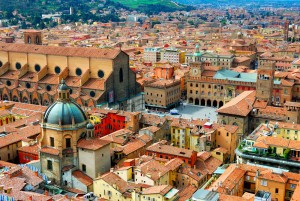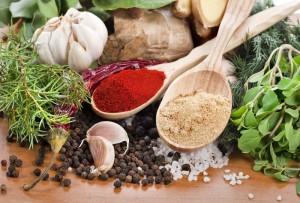Have you wondered what makes these seemingly simple dough products like pasta, pizza, lasagna exquisite dishes with a unique and unforgettable flavor?
It’s the sauces and spices used in traditional Italian cuisine of course.
Cucina Italiana is rich in culinary traditions belonging to different regions of the country and it is difficult to make a list of all the sauces that are prepared in the Italian cuisine, but we tried (as far as we could) to select for you some of the most typical sauces for different Italian regions.
Emilia-Romagna region
Ragù alla bolognese (Bolognese sauce)
Emilia-Romagna is famous for its varied and delicious cuisine. This area is also the birthplace of the world-famous Bolognese sauce. Here, in every home or restaurant you will be welcomed not only with a smile but also probably the first meal you will be offered is going to be Fettuccine „alla bolognese”.
The secret of the most popular sauce in the traditional Italian cuisine whose original recipe you can try in one of Bansko’s restaurants is to prepare it on a very slow fire.
Bolognese is made from minced meat, with added celery, onion and carrots. Once the products are sautéed, red wine and tomato juice are added to them.
The sauce is cooked until it thickens, and all liquid is evaporated. This is the sauce we are most used to associating with pasta but do not make the mistake while you are on holiday in Italy to order spaghetti Bolognese. You will not be served such a dish, as for the Italians, Bolognese’s consistency is not suitable for spaghetti.
So if you visit Italian restaurants, order fettuccine, tagliatelle, eggs or rice Bolognese to experience the truly unique taste of this unique Emilia-Romagna sauce.
Liguria region
Pesto alla Genovese
Pesto alla Genovese is a sauce that is typical of the Liguria region and we all love it because it gives a specific and unique flavor to the Italian cuisine. This sauce is consumed cold and, in addition to being used in traditional Italian cuisine as an addition to various pasta, it can also be used for rice salads, hors d’oeuvres, and more.
Pesto alla Genovese can be bought ready-made, but nothing compares with home-made fresh pesto. It is made with few ingredients – fresh basil, garlic, cedar nuts and cold-pressed olive oil and parmesan.
Walnut sauce
This is another typical Ligurian sauce. It is popular in Italy, but in Bulgaria you can taste it in very few Italian restaurants. Making walnut sauce is quick and easy, and if you decide to try, you’ll need nuts, old bread, milk, cedar nuts, grated parmesan, butter, garlic, and salt.
Bread is soaked in the milk. The garlic, salt, slightly roasted pine nuts, walnuts are crushed in a mortar and mixed with the soaked in milk and well squeezed bread and everything is squashed well. Finally, parmesan and butter are added. The sauce is ready when it reaches a smooth consistency.
Sicily region
Sicily is a land rich in aromas, spices and flavors, and it is difficult to tell which Sicilian sauces are the most popular, but still, our choice came across two Sicilian sauces that you can try not only in Sicily, but also in some restaurants in Bansko.
Pesto Trapanese
Prepared from peeled almonds, peeled tomatoes, garlic, basil, a spoon of Pecorino cheese, a pinch of salt, pepper and a little butter. To prepare it, you only need a blender. Simply put all the ingredients in it and mix until a homogeneous sauce is obtained.
Another classic sauce typical of Sicilian cuisine is Pasta alla Norma (sauce of fried eggplants and tomatoes). The eggplants are cut into pieces, salted and left for a few hours to release the bitterness and excess water from them.
While the eggplants are draining, put the peeled and chopped fresh tomatoes and crushed cloves of garlic in a pan and prepare a classic tomato sauce. The thoroughly drained eggplants are sautéed in olive oil or butter and added to the tomato sauce. Pasta alla Norma is added to spaghetti, macaroni or served as an appetizer with ricotta.
Campania region
Sauce “alla puttanesca”
Prepared mostly in the Campania region and is among the favorite sauces of tourists visiting the Italian restaurants in the area.
What distinguishes “alla puttanesca” from other popular sauces from traditional Italian cuisine is the presence of ingredients such as anchovies, capers, olives, garlic and chili. To prepare this sauce you will need all of the ingredients listed, plus tomatoes and cold-pressed olive oil.
Not so popular around the world, but very popular in Italy is the tuna sauce. You can try tuna sauce in some restaurants in Bansko, and if you want to prepare it yourself you will need: tuna (if you do not have fresh, canned will do), onions, tomatoes, parsley, marjoram and optionally olives.
The fish is cut into pieces and fried, chopped onions, tomatoes (peeled and cut into stacks), parsley and oregano are added. When the sauce thickens, you can add pitted and chopped olives to the finish.
Lazio region
The closer to the capital of Italy we get, sauces and spices are becoming more original. In Rome, for example, you can try “spaghetti alla carbonara” or pasta with “Gricia” sauce.
“Gricia” is a surprisingly delicious sauce made just from meat, Pecorino Romano cheese, olive oil, salt and pepper. This sauce combines perfectly with spaghetti, as well as rigatoni and bucatini.
There are many more types of sauces from the traditional Italian cuisine, but we’ll stop here because it is time to pay a little attention to the spices used in Italian cuisine and which are the main ingredient, thanks to which Italian food is recognized as the most delicious and aromatic cuisine in the world.
Italy is a country rich in wild herbs and exotic spices, which are distinguished by their memorable flavor and delicate aroma.
It is unthinkable to even imagine a traditional Italian dish that lacks fresh spices like basil, oregano, rosemary, garlic.
Popular spices in Italian cuisine
Basil
With a spicy flavor, this aromatic herb has a very pleasant aroma and a refreshing taste. Used in pizza, spaghetti, it is the main ingredient in pesto Genovese, also used in soups
Oregano
Translated from Greek, its name means “the joy of the mountains”. This spice is used in Italy since the time of the Roman Empire. The oregano has a delicate aroma and spicy flavor and is a must-have component of pizza and pasta.
Rosemary
The name of spice is translated as “sea dew”. This is due to the fact that it grows near the sea. Rosemary combines perfectly with potatoes, mutton, rabbit meat. (If you are coming to Bansko, stop at one of the Italian restaurants in Bansko and try a rosemary rabbit and potato – you will lick your fingers).
Savory
The spice has a spicy taste and aroma and is perfectly combined with vegetable dishes, salads, ham and cheese.
Capers
Capers have a slightly spicy taste, and this makes them very suitable for adding to salads, sauces, fish dishes, beef dishes.
Garlic
It is a common spice in many countries around the world, and it is hardly necessary to mention that there is no country where garlic is not used. In traditional Italian cuisine, garlic is used almost for all meals. Italians put it in salads, borscht, meat dishes, add it to spaghetti, pizza and sauces.


![[:bg]Област Лацио в Италия[:en]Lazio in Italy[:] | Leonardo Bansko](https://leonardobansko.com/wp-content/uploads/2018/01/italy-lazio-800x385.jpg)




